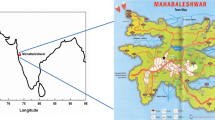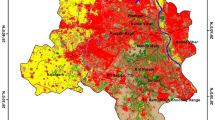Abstract
The variation in particulate mass and particulate types (PM2.5 and PM10) with respect to local/regional meteorology was analyzed from January to December 2014 (n = 104) for an urban location over the middle Indo-Gangetic Plain (IGP). Both coarser (mean ± SD; PM10 161.3 ± 110.4 μg m−3, n = 104) and finer particulates (PM2.5 81.78 ± 66.4 μg m−3) revealed enormous mass loading with distinct seasonal effects (range: PM10 12–535 μg m−3; PM2.5 8–362 μg m−3). Further, 56% (for PM2.5) to 81% (for PM10) of monitoring events revealed non-attainment national air quality standard especially during winter months. Particulate types (in terms of PM2.5/PM10 0.49 ± 0.19) also exhibited temporal variations with high PM2.5 loading particularly during winter (0.62) compared to summer months (0.38). Local meteorology has clear distinguishing trends in terms of dry summer (March to June), wet winter (December to February), and monsoon (July to September). Among all the meteorological variables (average temperature, rainfall, relative humidity (RH), wind speed (WS)), temperature was found to be inversely related with particulate loading (rPM10 −0.79; rPM2.5 −0.87) while RH only resulted a significant association with PM2.5 during summer (rPM10 0.07; rPM2.5 0.55) and with PM10 during winter (rPM10 0.53; rPM2.5 0.24). Temperature, atmospheric boundary layer (ABL), and RH were cumulatively recognized as the dominant factors regulating particulate concentration as days with high particulate loading (PM2.5 >150 μg m−3; PM10 >260 μg m−3) appeared to have lower ABL (mean 660 m), minimum temperature (<22.6 °C), and high RH (∼79%). The diurnal variations of particulate ratio were mostly insignificant except minor increases during night having a high wintertime ratio (0.58 ± 0.07) over monsoon (0.34 ± 0.05) and summer (0.30 ± 0.07). Across the region, atmospheric visibility appeared to be inversely associated with particulate (rPM2.5 −0.84; rPM10 −0.79) for all humid conditions, while at RH ≥80%, RH appeared as the most dominant factor in regulating visibility compared to particulate loading. The Lagrangian particle dispersion model was further used to identify possible regions contributing particulate loading through regional/transboundary movement.










Similar content being viewed by others
References
Banerjee, T., Singh, S. B., & Srivastava, R. K. (2011a). Development and performance evaluation of statistical models correlating air pollutants and meteorological variables at Pantnagar India. Atmospheric Research, 99, 505–517.
Banerjee, T., Barman, S. C., & Srivastava, R. K. (2011b). Application of air pollution dispersion modeling for source-contribution assessment and model performance evaluation at integrated industrial estate-Pantnagar. Environmental Pollution, 159, 865–875.
Banerjee, T., Murari, V., Kumar, M., & Raju, M. P. (2015). Source apportionment of airborne particulates through receptor modeling: Indian scenario. Atmospheric Research, 167–187.
Banerjee, T., Kumar, M., Mall, R. K., & Singh, R. S. (2017). Airing ‘clean air’ in clean India mission. Environmental Science and Pollution Research. doi:10.1007/s11356-016-8264-y.
Bibi, H., Alam, K., Chishtie, F., Bibi, S., Shahid, I., & Blaschke, T. (2015). Intercomparison of MODIS, MISR, OMI, and CALIPSO aerosol optical depth retrievals for four locations on the indo-Gangetic plains and validation against AERONET data. Atmospheric Environment, 111, 113–126.
Crawford, J., Chambers, S., Cohen, D. D., Williams, A., Griffiths, A., Stelcer, E., & Dyer, L. (2016). Impact of meteorology on fine aerosols at Lucas Heights. Australia. Atmospheric Environment., 145, 135–146.
De, U. S., Dube, R. K., & Rao, G. S. P. (2005). Extreme weather events over India in the last 100 years. J. Ind. Geophys. Union., 9, 173–187.
Draxler RR, Rolph GD (2003) HYSPLIT (HYbridSingle- Particle Lagrangian IntegratedTrajectory) Model access via NOAA ARL READY Website (http://www.arl.noaa.gov/ ready/hysplit4.html). NOAA Air Resources Laboratory: Silver Spring, MD.
Elminir, H. K. (2007). Relative influence of air pollutants and weather conditions on solar radiation—part 1: Relationship of air pollutants with weather conditions. Meteorology and Atmospheric Physics, 96, 245–256.
Ganguly, D., Ginoux, P., Ramaswamy, V., Winker, D. M., Holben, B. N., & Tripathi, S. N. (2009). Retrieving the composition and concentration of aerosols over the Indo-Gangetic basin using CALIOP and AERONET data. Geophysical Research Letters, 36(13), 1–5.
Khan, A. J., Li, J., Dutkiewicz, V. A., & Husain, L. (2010). Elemental carbon and sulfate aerosols over a rural mountain site in the northeastern United States: Regional emissions and implications for climate change. Atmospheric Environment, 44, 2364–2371.
Kumar, M., Singh, R. S., & Banerjee, T. (2015a). Associating airborne particulates and human health: Exploring possibilities. Environment International, 84, 201–202.
Kumar, M., Tiwari, S., Murari, V., Singh, A. K., & Banerjee, T. (2015b). Wintertime characteristics of aerosols at middle Indo-Gangetic Plain: Impacts of regional meteorology and long range transport. Atmospheric Environment, 104, 162–175.
Kumar, M., Singh, R. K., Murari, V., Singh, A. K., Singh, R. S., & Banerjee, T. (2016). Fireworks induced particle pollution: a spatio-temporal analysis. Atmospheric Research, 180, 78–91.
Kumar, M., Raju, M. P., Singh, R. K., Singh, A. K., Singh, R. S., & Banerjee, T. (2017). Wintertime characteristics of aerosols over middle Indo-Gangetic Plain: Vertical profile, transport and radiative forcing. Atmospheric Research, 183, 268–282.
Murari, V., Kumar, M., Barman, S. C., & Banerjee, T. (2015). Temporal variability of MODIS aerosol optical depth and chemical characterization of airborne particulates in Varanasi, India. Environmental Science and Pollution Research, 22, 1329–1343.
Murari, V., Kumar, M., Singh, N., Singh, R. S., & Banerjee, T. (2016). Particulate morphology and elemental characteristics: variability at middle Indo-Gangetic Plain. Journal of Atmospheric Chemistry, 73, 165–179.
Olcese, L. E., & Toselli, B. M. (1998). Statistical analysis of PM10 measurements in Cordoba City, Argentina. Meteorology and Atmospheric Physics, 66, 123–130.
Ramanathan, V., & Carmichael, G. (2008). Global and regional climate changes due to black carbon. Nature Geoscience, 1, 221–227.
Sen, A., Ahammed, Y. N., Banerjee, T., et al. (2016). Spatial variability in ambient atmospheric fine and coarse mode aerosols over Indo-Gangetic plains, India and adjoining oceans during the onset of summer monsoons, 2014. Atmospheric Pollution Research, 7(3), 521–532.
Sen, A., Abdelmaksoud, A. S., Nazeer Ahammed, Y., Alghamdi, M. E., Banerjee, T., et al. (2017). Variations in particulate matter over Indo-Gangetic Plains and Indo-Himalayan Range during four field campaigns in winter monsoon and summer monsoon: role of pollution pathways. Atmospheric Environment. doi:10.1016/j.atmosenv.2016.12.054.
Singh, A., & Dey, S. (2012). Influence of aerosol composition on visibility in megacity Delhi. Atmospheric Environment, 62, 367–373.
Singh, N., Murari, V., Kumar, M., Barman, S. C., & Banerjee, T. (2017). Fine particulates over South Asia: review and meta-analysis of PM2.5 source apportionment through receptor model. Environmental Pollution, 223, 121–136.
Tai, A. P. K., Mickley, L. J., & Jacob, D. J. (2012). Impact of 2000-2050 climate change on fine particulate matter (PM2.5) air quality inferred from multi-model analysis of meteorological modes. Atmospheric Chemistry and Physics, 12, 11329–11337.
Turalioglu, F. S., Nuhoglu, A., & Bayraktar, H. (2005). Impacts of some meteorological parameters on SO2 and TSP concentrations in Erzurum. Turkey. Chemosphere., 59, 1633–1642.
Yadav, S., Praveen, O. D., & Satsangi, P. G. (2015). The effect of climate and meteorological changes on particulate matter in Pune. India. Environ. Monit. Assess., 187, 402.
Zeri, M., Junior, J. F. O., & Lyra, G. B. (2011). Spatiotemporal analysis of particulate matter, sulfur dioxide and carbon monoxide concentrations over the city of Rio de Janeiro. Brazil. Meteorol. Atmos. Phys., 113, 139–152.
Acknowledgements
Present submission is financially supported by University Grants Commission, New Delhi (F. No. 41-1111/2012, SR), and the Science and Engineering Research Board, Department of Science and Technology, New Delhi (F. No. SR/FTP/ES-52/2014). Meteorological data from wunderground.com is acknowledged. Ground level particulate data and meteorological data at Varanasi were courtesy of the Central Pollution Control Board and the Indian Meteorological Department, respectively. Authors also acknowledge the NOAA-ARL for the HYSPLIT transport model and the NCEP/NCAR Reanalysis team for providing synoptic meteorological data. The guidance and cooperation provided by the Director, IESD-BHU, is also acknowledged.
Author information
Authors and Affiliations
Corresponding author
Electronic supplementary material
ESM 1
(DOCX 43 kb)
Rights and permissions
About this article
Cite this article
Murari, V., Kumar, M., Mhawish, A. et al. Airborne particulate in Varanasi over middle Indo-Gangetic Plain: variation in particulate types and meteorological influences. Environ Monit Assess 189, 157 (2017). https://doi.org/10.1007/s10661-017-5859-9
Received:
Accepted:
Published:
DOI: https://doi.org/10.1007/s10661-017-5859-9




